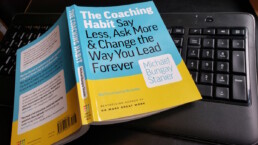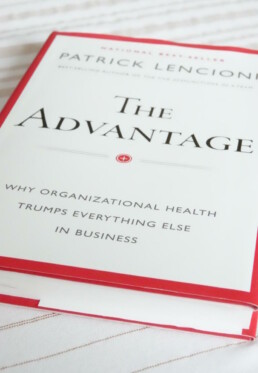The Coaching Habit
by Dima Shevchenko
The need for effective coaching is especially pronounced in this rapidly evolving age when quality learning is the cornerstone of personal and professional development. Michael Bungay Stanier’s bestseller The Coaching Habit presents a simple, yet profound idea: the art of asking questions can revolutionize the way we lead...
Why Questions?
It is considered common sense for managers and leaders to fulfill the mission of their organizations by engaging with their team. The most direct approach to achieve the necessary goals seems to be communication in the form of imperative statements and advice. The author does not dismiss the effectiveness of good advice but argues that constant application of that approach is not effective.
There are 3 problems that such approach creates:
1. Overdependence: the team is less capable of acting without the continuous guidance of their leader.
2. Overwhelming: having to take an active role in the work of employees is additional work that the leader does not have to do.
3. Disconnection: Leaders are too busy solving the team’s problems instead of focusing on the important to leaders tasks.
Stanier suggests that the solution is coaching. Coaching is nurturing others to increase their potential and performance. Leaders often overlook the ability of the team to find a solution that works best. When a team member is asked a question rather than told what to do, they are given an opportunity to become more independent, while still receiving the answer they need.
The 7 Essential Questions Leaders Should Ask Their Team Members:
1. What is on your mind? This is a great conversation starter that will uncover what matters most.
2. And what else? Stopping at the first answer often closes the opportunity to have the discussion that needs to happen most. The author encourages the readers to be curious and ask this question until the answer is “there is nothing else.”
3. What is the real challenge here for you? This is the invitation for the team to identify and offer a solution to the issue at hand without depending on the leader.
4. What do you want? It is necessary for leaders to address wants of their team to sustain healthy relationships. People expressing what they really want often subconsciously communicate what they really need.
5. How can I help? It is best to eliminate the guess of what other people need help with and just ask.
6. If you are saying yes to this, what are you saying no to? A coach who asks this question helps the person to set their priorities and follow through on their commitments well.
7. What was most useful for you? Analysis is a key aspect of learning
The author lists 8 tips that help ask questions in a more effective way:
1. Ask one question at a time. Do not rush to asking another question until you get the answer.
2. When you have a question, get straight to it without prelude.
3. Stop offering advice with a question mark attached.
4. Ask questions starting with What instead of Why.
5. Be comfortable with silence after asking a question.
6. Listen attentively to the answers.
7. Acknowledge the answers you get.
8. Do not restrict yourself to one communication channel.
Key Takeaways: Humility and Patience
The themes that stand out are humility and patience. Every competent leader has rich problem solving experience. However, leaders need to understand that their team has the capability to find a solution that is truly best for their situation.
This message of this book resonates with our team at Plains Edge as one of our guiding values is Curiosity. We seek to ask open-ended questions and bring a discovery mindset to our conversations with clients. This frequently results in shared identification of contextually appropriate solutions.
Sustainability
Good for the Earth and Good for Business
by Judy Martens
The modern organization seeks to incorporate green alternatives to existing strategies in order to grow in social responsibility and accountability to stakeholders.
Unfortunately, these more sustainable options often carry a premium. This may cause both businesses and charities to assume that caring for the environment is out of their reach. In the following paragraphs we will share sustainable practices that many organizations can embrace. In some cases, these practices reduce costs.
Recently, we were inspired by the article, “8 Sustainable Business Practices – Are you doing your part?” We were challenged to thoughtfully review our own practices.
Sustainability is about hope
Just as our bodies need nutrition and rest to be healthy and achieve equilibrium,
”The ecological systems on which we depend are naturally self-renewing. Schools of fish replenish themselves. Forests reseed themselves. Groundwater is renewed by the rain. Forests grow by absorbing carbon dioxide and giving off oxygen. We can use these systems in ways that allow them to regularly renew themselves. Humans and all living creatures can live sustainably on the earth...”
Stress can cause sickness and disease in the human body, which severely limits function. Likewise,
“… we can also put so much stress on these natural systems that they can no longer function as they should nor renew themselves adequately. The stress we put on the earth depends both on how we meet our needs, and on how much we use.” 1
Environmental contaminants cause stress and disease in our bodies. However, if we make changes and the environment has a chance to renew, our bodies will also have a chance to recover health. A healthier planet can potentially be a place of hope for our children and grandchildren.
Good for Business
Buying office equipment off lease, making digital copies instead of printing, installing LED bulbs and using timers for lights and temperature controls are sustainable practices that also reduce costs.
Higher costs associated with environmental products may be recovered with additional sales from customers that are passionate about caring for the earth.
A socially responsible organization gains credibility with customers or donors. Green business practices can bolster both customer loyalty and a sense of community.
Sustainability and environmental responsibility are becoming more important to all. A 2015 Global Corporate Sustainability Report indicated that 66% of consumers in the global market are willing to spend more on a sustainable brand. The Millennial generation participants surveyed responded with an even greater 73%. (Forbes.com)
Sustainable organizations also attract and retain Millennial generation employees who want to work for an organization that makes a positive impact on the world around them.
Being environmentally responsible is planning for the long-term future of the organization. Visible changes can differentiate among competitors. It may be better to innovate before government regulations force changes upon organizations.
Our experience
We are a small business with fewer than ten staff. We do not have a central office and our staff work mostly from home or client offices.
Here are some of our sustainable practices:
Paper:
- Scan documents to reduce paper usage.
- Buy recycled paper to use in office printer.
- Recycle paper waste– We donate paper from our shredder to our local church, which is then upcycled into fire-resistant fiber insulation for homes. Prairie Fibre Inc
- Pay most bills online using Plooto, an online payment processing service which integrates with Quick Books Online and our bank.
- Invite our customers to pay electronically.
- Use reusable alternatives to sticky notes in home office.
Technology:
- Buy off-lease computers instead of new.
- Use cell phones beyond original contracts, then recycle them. Check out this neat program from Telus.
- Recycle devices, printers, computers whenever possible. Check out local recycling programs.
- Use online servers instead of own local servers. Examples are Microsoft SharePoint, Google Docs, OVH cloud servers, Digital Ocean…
Transportation:
- Drive a fuel-efficient vehicle or a hybrid, if possible, reducing fuel consumption and emissions.
- Book virtual meetings to reduce travel.
- Ride bicycle to local client offices.
- Encourage carpooling to client offices when multiple staff need to attend at the same location.
- Give employees flexible work from home options, so they commute less.
General:
- Buy local, especially for staff events and gifts.
- Recycle beverage containers and use re-useable or compostable tableware and supplies for staff events.
- Schedule lighting and plugs based on time of day.
- Control temperature in our home office using a programmable thermostat, as well as opening windows or using alternate forms of heat.
- Use LED bulbs in home office to reduce energy.
- Decorate with live plants in home office for cleaner air.
- Use environmentally responsible cleaning supplies.
- Encourage staff to consider the environment, by offering LED bulbs, green cleaning supplies and recycling boxes for their home office space.
- Ensure paper generated in staff home offices are shredded for confidentiality and then recycled.
We are currently looking at questions like: How shall we dispose of our used computer equipment? Should we include a “consider the environment before printing this email” message on the bottom of emails?
Encourage connection
We encourage you to read the article which inspired us and try some of these ideas. We welcome your input/suggestions. If you work with a charity or not-for-profit, please share your stories of embracing environmental stewardship with us at info@plainsedge.com. We look forward to hearing from you.
1 Schrock-Shenk, D. (2002) Basic trek: venture into a world of enough. Waterloo, ON: Herald Press.
The Advantage by Patrick Lencioni
Greatest Opportunity for Improvement
by Dima Shevchenko
In business, organizational health represents “…the greatest opportunity for improvement and competitive advantage.” Many miss out on substantial performance improvement by disregarding the discipline that Patrick Lencioni presents in his book, “The Advantage.”
Improving organizational health is far more important than a new strategy, a new way of efficiently cutting costs, implementing new technology, or finding a good location to place an ad. We live in an age when the world is oversaturated with accessible information. In competition with other organizations, being good is not enough. One must be excellent to stand out from others. Employers do everything possible to find the masters of their trade. Leaders spend resources to improve strategies, marketing, and finance. And yet, most find that this is barely enough to enter the competition. What can be done in the grind of competition? The simplicity of improving organizational health makes it seem a deceptively easy way to boost the performance of any organization.
What is Organizational Health?
Organizational health is integrity formed by the presence of a cohesive leadership team and clarity which makes the organization whole, consistent, and complete. Lencioni suggests that the idea of organizational health is best understood when the two basic qualities of a successful organization are contrasted: intelligence and health. Intelligence consists of strategy, marketing, finance, and technology. Health is easier to comprehend when one looks at the fruit of a healthy organization: minimal politics, minimal confusion, high morale, high productivity, and low turnover.
The Advantage: Organizational Health
The profitability of organizational health is real and pervasive, but difficult to measure because it is qualitative, not quantitative. It extends from the productivity of employees in the workplace to happiness in the employees’ personal lives. Unfortunately, health is often neglected. However, time spent for the sake of advancing health, also results in the development of intelligence. “Organizations where health is maintained inevitably grow smarter over time,” and “intelligence does not provide any inherent advantages for becoming healthy.”
How is Organizational Health Achieved?
Lencioni presents four disciplines:
- Build a cohesive leadership team. Embrace trust, conflict, commitment, accountability, and results.
- Create clarity. Answer 6 crucial questions about the organization:
- Why do we exist?
- How do we behave?
- What do we do?
- How will we succeed?
- What is important right now?
- Who must do what?
- Overcommunicate clarity. There is always room for communicating what is important. “Great leaders see themselves as Chief Reminding Officers as much as anything else.”
- Reinforce clarity. Make the environment of the organization fit the answers to the six questions.
- Replace bureaucracy with human systems
- Conduct meetings well
- Hire people that fit
Key Takeaway: Character
Something that stood out to me from the book is the importance of character. Performance is not only defined by what a person knows and how well they are able to execute their knowledge, but is also intertwined with virtue, love, power of will, determination, and other positive character qualities. It is just as important to develop character as it is to develop professional skills.
In conclusion, Lencioni draws the readers’ attention to the problem that most organizations have: many organizations are intelligent, few are healthy.
What’s in a Name?
Starting a company can be an exhilarating journey. Discovering a need for something you or your team are specially qualified to meet, then crafting the solution and finally watching as your product or service finds acceptance is a special and unique experience. As you develop your company you have frequent opportunities to explain your solution or your mission. How can you do that effectively?
We know a company name plays an important role in communicating one’s mission. The role can be direct. Names like Steinbach Bible College or Swift High Speed Internet leave no doubt as to what these organizations provide. On the other hand, other names rely entirely on reputation and connections developed over time. McDonald’s and Rolls-Royce trigger mental associations among us that define our expectations of these companies.
At Plains Edge, we developed a name that captures our personal background, our present location and our mission. Pat grew up in the Black Forest of southern Germany and still appreciates wooded hills and curving roads. Judy’s family farmed the flat prairies west of the Red River, so she enjoys a slow sunset against a huge sky. As a result, we both enjoy our present location on the border between the prairies and the Canadian Shield– or Plains Edge.
For our clients, we tell the story of hiking in the woods; each twist in the trail revealing something new– perhaps wild strawberries or a surprised skunk. That is a great adventure story but a poor way to manage the finances of an organization. We seek to help Boards of Directors and business owners understand their finances clearly and to step out onto the prairie. Here they can see the trail for miles and anticipate that storm building in the western sky.
If you have an inspiring story behind your company name, tell us about it in an email to Info@PlainsEdge.com.




